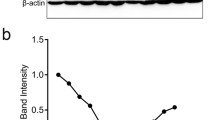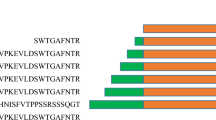Abstract
3C protease is one of the most important proteases in enteroviruses, which is responsible for several cleavages of the viral polyprotein, leading to virus maturation. It has several harmful effects on host cells, such as the induction of caspase-mediated apoptosis and the cleavage of various proteins like P53, TATA-binding protein (TBP), histone H3, octamer-binding protein 1 (Oct-I) and DNA polymerase III. In this study, we aimed to construct a structure to express enterovirus 71 3C protease, consisting of a 3C protease sequence and two kinds of linkers including rigid and cleavable. As a result of cloning the structure into a pEGFP-N1 vector, two forms of constructions were expressed and verified by western blotting analysis including a 3C-Linker-Cleavage site (3C-L-CL) and a 3C-Linker (3C-L) without a cleavage site. In 3C-L-CL construction, 3C protease is released from fused GFP by cleave cleavage site. In 3C-L construction, 3C protease was expressed in fusion with GFP. In fact, one of the constructions produced two forms of 3C proteases, a free 3C and a 3C fused with GFP. This study shows that free 3C is preferred over the second form (3C with linker) because it is not connected to other peptides, and its protease activity is not affected. The designed structures could be used as useful tools for 3C protease expression and investigation of its interactions with cellular signaling pathways such as interferon pathway.



Similar content being viewed by others
References
Amet N, Lee H-F, Shen W-C (2009) Insertion of the designed helical linker led to increased expression of tf-based fusion proteins. Pharm Res 26(3):523
Arai R, Ueda H, Kitayama A, Kamiya N, Nagamune T (2001) Design of the linkers which effectively separate domains of a bifunctional fusion protein. Protein Eng 14(8):529–532
Bai Y, Shen W-C (2006) Improving the oral efficacy of recombinant granulocyte colony-stimulating factor and transferrin fusion protein by spacer optimization. Pharm Res 23(9):2116–2121
Bergeron LM, Gomez L, Whitehead TA, Clark DS (2009) Self-renaturing enzymes: design of an enzyme-chaperone chimera as a new approach to enzyme stabilization. Biotechnol Bioeng 102(5):1316–1322
Chen X, Zaro JL, Shen W-C (2012) Pharmacokinetics of recombinant bifunctional fusion proteins. Expert Opin Drug Metab Toxicol 8(5):581–595
Chen X, Zaro JL, Shen W-C (2013) Fusion protein linkers: property, design and functionality. Adv Drug Deliv Rev 65(10):1357–1369
Cui S, Wang J, Fan T, Qin B, Guo L, Lei X, Wang J, Wang M, Jin Q (2011) Crystal Structure of Human Enterovirus 71 3C Protease. J Mol Biol 408(3):449–461. https://doi.org/10.1016/j.jmb.2011.03.007
George RA, Heringa J (2002) An analysis of protein domain linkers: their classification and role in protein folding. Protein Eng Des Sel 15(11):871–879
Klein JS, Jiang S, Galimidi RP, Keeffe JR, Bjorkman PJ (2014) Design and characterization of structured protein linkers with differing flexibilities. Protein Eng Des Sel 27(10):325–330. https://doi.org/10.1093/protein/gzu043
Lee M, Bang K, Kwon H, Cho S (2013) Enhanced antibacterial activity of an attacin-coleoptericin hybrid protein fused with a helical linker. Mol Biol Rep 40(6):3953–3960. https://doi.org/10.1007/s11033-012-2472-4
Lei X, Sun Z, Liu X, Jin Q, He B, Wang J (2011) Cleavage of the adaptor protein TRIF by Enterovirus 71 3C inhibits antiviral responses mediated by toll-like receptor 3. J Virol 85(17):8811–8818. https://doi.org/10.1128/jvi.00447-11
Lei X, Xiao X, Xue Q, Jin Q, He B, Wang J (2013) Cleavage of interferon regulatory factor 7 by enterovirus 71 3C suppresses cellular responses. J Virol 87(3):1690–1698
Lei X, Han N, Xiao X, Jin Q, He B, Wang J (2014) Enterovirus 71 3C inhibits cytokine expression through cleavage of the TAK1/TAB 1/TAB 2/TAB 3 complex. J Virol 88(17):9830–9841
Li G, Huang Z, Zhang C, Dong B-J, Guo R-H, Yue H-W, Yan L-T, Xing X-H (2016) Construction of a linker library with widely controllable flexibility for fusion protein design. Appl Microbiol Biotechnol 100(1):215–225. https://doi.org/10.1007/s00253-015-6985-3
Ma G-H, Ye Y, Zhang D, Xu X, Si P, Peng J-L, Xiao Y-L, Cao R-Y, Yin Y-L, Chen J, Zhao L-X, Zhou Y, Zhong W, Liu H, Luo X-M, Chen L-L, Shen X (2016) Identification and biochemical characterization of DC07090 as a novel potent small molecule inhibitor against human enterovirus 71 3C protease by structure-based virtual screening. Eur J Med Chem 124(3):981–991. https://doi.org/10.1016/j.ejmech.2016.10.019
Marqusee S, Baldwin RL (1987) Helix stabilization by Glu-… Lys + salt bridges in short peptides of de novo design. Proc Natl Acad Sci 84(24):8898–8902
McCormick AL, Thomas MS, Heath AW (2001) Immunization with an interferon-γ–gp120 fusion protein induces enhanced immune responses to human immunodeficiency virus gp120. J Infect Dis 184(11):1423–1430
Renert-Yuval Y, Marva E, Weil M, Shulman LM, Gencylmaz N, Sheffer S, Wolf DG, Molho-Pessach V (2016) Coxsackievirus A6 polymorphic exanthem in Israeli children. Acta Dermato Venereol 96(4):546–549
Robinson CR, Sauer RT (1998) Optimizing the stability of single-chain proteins by linker length and composition mutagenesis. Proc Natl Acad Sci 95(11):5929–5934
Schmidt SR (2009) Fusion-proteins as biopharmaceuticals—applications and challenges. Curr Opin Drug Discov Dev 12(2):284–295
Schulte S (2009) Half-life extension through albumin fusion technologies. Thromb Res 124:S6–S8
Shang L, Xu M, Yin Z (2013) Antiviral drug discovery for the treatment of enterovirus 71 infections. Antiviral Res 97(2):183–194. https://doi.org/10.1016/j.antiviral.2012.12.005
Shang L, Zhang S, Yang X, Sun J, Li L, Cui Z, He Q, Guo Y, Sun Y, Yin Z (2015) Biochemical characterization of recombinant Enterovirus 71 3C protease with fluorogenic model peptide substrates and development of a biochemical assay. Antimicrob Agents Chemother 59(4):1827–1836. https://doi.org/10.1128/aac.04698-14
Wang X, Peng W, Ren J, Hu Z, Xu J, Lou Z, Li X, Yin W, Shen X, Porta C (2012) A sensor-adaptor mechanism for enterovirus uncoating from structures of EV71. Nat Struct Mol Biol 19(4):424–429
Weng K-F, Li M-L, Hung C-T, Shih S-R (2009) Enterovirus 71 3C protease cleaves a novel target CstF-64 and inhibits cellular polyadenylation. PLoS Pathog 5(9):e1000593
Zhao HL, Yao XQ, Xue C, Wang Y, Xiong XH, Liu ZM (2008) Increasing the homogeneity, stability and activity of human serum albumin and interferon-α2b fusion protein by linker engineering. Protein Expr Purif 61(1):73–77
Acknowledgements
This report has been extracted from a Ph.D. thesis with following registration number: OG-94153. It was supported by grants from the Health Research Institute, Tropical and Infectious Disease Research Center, Ahvaz Jundishapur University of Medical Sciences, Ahvaz, Iran.
Author information
Authors and Affiliations
Corresponding author
Ethics declarations
Conflict of interest
There is no conflict of interests.
Rights and permissions
About this article
Cite this article
Rasti, M., Makvandi, M., Teimoori, A. et al. Designing a Self-Cleavable Construction Expressing Enterovirus 71 3C Protease. Iran J Sci Technol Trans Sci 44, 615–620 (2020). https://doi.org/10.1007/s40995-020-00877-5
Received:
Accepted:
Published:
Issue Date:
DOI: https://doi.org/10.1007/s40995-020-00877-5




